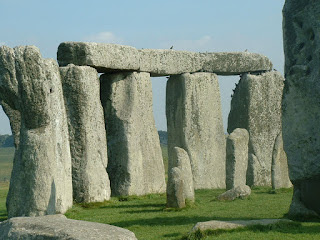that is where the stones were.......
It appears to me to be self-evident that if I was into the manufacture of stone axes or other implements, I would use whatever raw materials were to hand at the time -- and if there were boulders lying around in the neighbourhood that looked promising, of course I would do some experiments and use them if they were suitable. Why anybody should seek to deny that piece of common sense is beyond me -- but apparently there are those who insist that our Stone Age ancestors would only ever have used suitable rocks in the places where they outcrop. This point is of course maintained by those who believe that stone axes and other tools were invested somehow with special or sacred qualities. I can accept that for "ceremonial" implements which were clearly never intended to be USED, but surely, for everything else, the things made were designed for use, in the knowledge that they would eventually break and be thrown away. The utilitarian was far more important in implement manufacture than the ceremonial. So stone procurement was a process involving the minimisation of effort -- our ancestors knew all about the principle of costs versus benefits.
In that process opportunism must have been an important principle.
The word that is really interesting here is "deterministic" -- and if we apply the phrase to megalithic structures like standing stones, stone rows and circles, cromlechs, long barrows, round barrows and even cist graves, I think there is a great deal of evidence to suggest that the siting of these features was almost always associated with the chance occurrence of suitable slabs, boulders or pillars in the landscape. In West Wales, as far as we can make out, all of the megalithic structures are made of stones picked up in the immediate vicinity. I am not aware of a single ancient monument that was made with the use of large stones carried in from somewhere else.
On that last point, I part company with the members of MPP's research team, who seem to think that in order for a megalithic monument (like the Waun Mawn stone settings, or Bedd Arthur, or Bedd yr Afanc, or Pentre Ifan) to be built, the site had to be pre-determined according to some "sacred" alignment or landscape setting and then the stone had to be FETCHED from somewhere else. Even more bizarre, there is the belief that the act of fetching and carrying was in itself a sign of homage or tribute, with tribulations endured and difficulties overcome almost as an act of worship.........
It's sad that this style of thinking underpins much of the wildly exotic narrative developed by Parker Pearson and his merry gang with regard to quarrying, lost circles, stone haulage and so forth -- with Stonehenge as the distant glorious beacon and focal point of almost every Neolithic effort going on within a radius of 300 miles. Quasi-religious and quasi-political claptrap, if you don't mind me saying so.......
================================
In Stephen's paper, he has a very comprehensive list of references on erratics and their distributions, and on this blog we have of course referred to many of them over the years -- especially those involving geologists and glacial geomorphologists. A short selection:
Overweel, C.J. 1977 'Distribution and transport of Fennoscandinavian indicators', Scripta Geologica 43, 1-117.
Williams-Thorpe, O., Aldiss, D., Rigby, I.J., and Thorpe, R.S. 1999 'Geochemical provenancing of igneous glacial erratics from southern Britain, and implications for prehistoric stone implement distributions', Geoarchaeology 14, 209-46.
Shotton, F.W. 1976 'The stone axe trade and Quaternary glaciation', Quat. Res. Newsl. (Nov. 1976), 4-6.
Cummins, W.A. 1977 'Stone axe trade – or glacial erratics?', Current Archaeol. 61, 42-43.
Sandford, K.S. 1929 'The erratic rocks and the age of the southern limit of glaciation in the Oxford district', Quart. Jnl Geol Soc., 359-88.




No comments:
Post a Comment